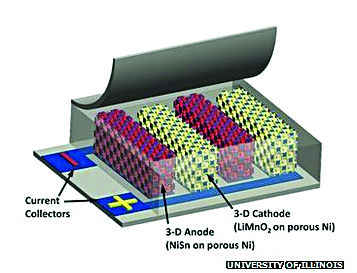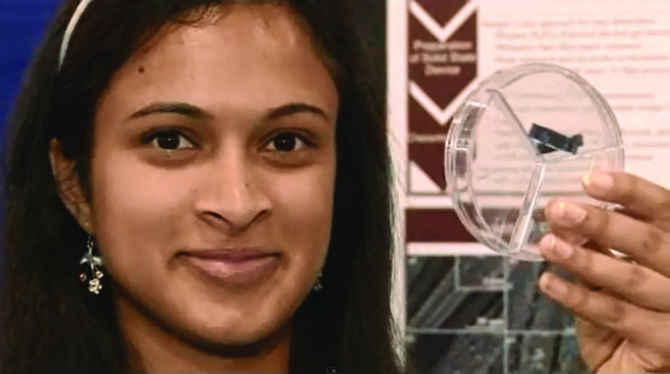BATTERY! What the future holds for battery technology
It may seem like battery technology hasn't moved forward but here are some exciting developments that may greatly improve the batteries powering your gadgets.

The technology that powers batteries doesn’t appear to be developing as fast as we’d like them to. As far as smartphones and tablets go, we are still using the same old Lithium-ion batteries.
 Survey
SurveyHowever, one may also argue that battery capacities are on the rise. But that’s only logical isn’t it? What else is going to drive those high-res, PPI heavy displays, the quad-core processors and those lovely graphics without you having to run to charge your mobile device every other hour? So, higher milli-ampere hour rating on the battery should never be taken to mean that the tech as such is improving. Innovation is happening on the system-on-chip front, with changes in micro-architectures which put less load on the battery life. But with our hunger for high resolution, high pixel-density screens, more graphics-heavy games, there is only so much you can innovate. At some point, optimisation will reach a limit and the only option left will be to improve on existing battery tech.
Sure, we have found a way around this issue, partly. If you have noticed, the market these days is flooded with one accessory which everyone is claiming to be a lifesaver – portable power banks. We agree that these Li-ion portable power chargers are impressive when you really need that extra bit of battery juice in emergency situations. Despite phone and tablets having greater battery capacities and optimised SoCs, there is barely a device which can go two days without needing a supplemental charge. Unless you are one of those rare people who have a smartphone but no Internet access, you can stretch the phone to two full days without a charge. In such cases, it helps if you have a portable charger around. But all said and done, that is still a roundabout way of addressing the issue at hand. With smartphones, it’s a no-brainer, portable power banks can be easily carried around. When it comes to charging tablets, which have a higher battery capacity, the power banks get relatively heavier. Moreover, these are just solutions for mobile devices – a fraction of the possible devices using batteries. What about cameras? What about electric vehicles? Battery technology innovation needs to happen from the ground up. We came across three solutions that may just help.
3D microbatteries
Researchers at the University of Illinois have developed a microbattery array which employs 3D electrodes. The claim is that these batteries are much powerful than even the best supercapacitor and are capable of charging 1000 times faster than current batteries. The 3D electrodes have small intertwined fingers that reach into each other thereby increasing the surface area and bringing the anode and cathode closer, so that the ions and electrons do not have to travel far. The principle is the same; electrons moving from the anode to the cathode when the battery is under use and charged ions moving via the electrolyte. The researchers have found a way to integrate the anode and cathode at a microscale. The transfer of electrons in the 3D microbattery array is happening at a micro-scale level, and the distance between cathode and anode is less, the energy generated is quite high. As the electrodes are closer, even recharging is speedy. The best part is that the researchers claim that their technology is scalable. So you can have microbatteries powering your cellphones as well as your electric car. Also the size of the batteries will be much smaller. The only concern at the moment is with the issue of robustness – any short circuit within the microbattery can be hazardous. This sentiment is echoed by the head of the research group Professor King, who states that the current microbatteries use a combustible electrolyte. The aim is to move to non-combustible polymer electrolytes. According to Prof. King, the trials of his microbattery as a power source in electronic devices should begin by the end of year.
3D microbatteries
Supergirl’s supercapacitor
While our phone and tablets are increasing their battery capacities, the amount of time taken to charge these devices is also increasing progressively. How about reducing that time to under a minute?
Well, an 18-year old Indian-American Eesha Khare has developed a supercapacitor that she claims can charge a cellphone in 20 seconds. She has developed a supercapacitor that can hold a large amount of energy in a small volume. It is quite small and can easily fit inside cellphone batteries and other electronic devices, thereby allowing them to fully charge between 20-30 seconds. Another impressive feat of this supercapacitor is its ability to undergo upto 10,000 charge-recharge cycles which is 10 times the number of cycles current cellphone batteries are capable of. Also Eesha’s supercapacitor is flexible which immediately makes it eligible for use in the future in rollable displays and even electric car batteries. Although she has only demoed this tech using an LED bulb so far, this invention is so impressive that it won Eesha the Intel Foundation Young Scientist Award this year from among 1,700 participants from 70 countries.
The implications of this invention are pertinent to each and everyone of us, as we are tired of long charging times. We just hope this technology sees the light of the day pretty soon. Fingers crossed.
Eesha Khare with her supercapacitor prototype
Graphene supercapacitors
Many scientific inventions and discoveries can be attributed to accidents – the scientist tending to stumble upon one thing while looking for something else. Something similar happened with researcher Richard Kaner and his student Maher El-Kady of the California NanoSystems Institute at UCLA. After devising a way to make super-thin (one-atom thick) graphene wafer sheets using a DVD burner of all devices, El-Kady decided to try lighting a bulb with one of the small square of those graphene sheets – and it worked!
That was the Eureka moment! When the researchers realised that they had stumbled upon an energy storage medium which also has the ability to charge/discharge quickly and we are talking in seconds here. Generally, the batteries that we use are high energy storage devices but have painfully slow charge/discharge cycles whereas a capacitor has a low energy, high power and very quick charge/discharge times. The graphene micro-supercapacitor which is what the researchers are working on is both high energy and high power device with quick charge/recharge cycles.
Traditionally fabricating graphene micro-supercapacitor involved a labour-intensive process, but Kaner and El-Mady’s method of using a DVD burner to make thin graphene sheets if scaled can work out to be a much cheaper way to produce the micro-supercapacitors.
You have over 100 micro-supercapacitors on a single disc in under 30 minutes. For any supercapacitor to be effective, the two separate electrodes have to be positioned in a way that the surface area between them is maximised so as to hold more charge.
The researchers from UCLA placed the electrodes side-by-side using an interdigitated pattern thereby increasing surface area available for each of the electrodes at the same time reducing the distance for the ions to travel (something similar to what we saw in microbatteries above). Since these graphene supercapacitors are flexible, bendable, twistable in nature they can be used as energy-storage devices in flexible electronics such as roll-up display or TVs, e-paper as well as wearable electronics. Currently the team is looking for industry partners to help them mass produce the graphene micro supercapacitors.
|

